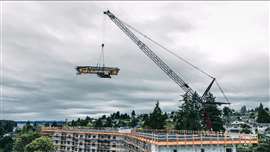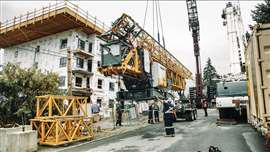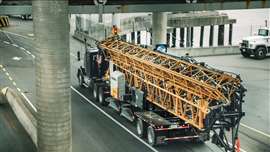Canadian challenge for Liebherr tower crane
18 July 2024
Canadian crane rental company Bigfoot Crane Company used a Liebherr 81 K.1 fast erecting tower crane for a residential construction project in Nanaimo, Canda.
The 81 K.1 has a maximum lifting capacity of 6 tonnes, a maximum radius of 48 metres and a jib head lifting capacity of 1.35 tonnes.
Construction of the Departure Bay apartment building presented Bigfoot Crane and the contractor Westurban Developments with several challenges, largely due to the complex nature of the structure and the conditions on site.
 The 81 K.1 crane was on site in British Columbia for a year. (Photo: Liebherr)
The 81 K.1 crane was on site in British Columbia for a year. (Photo: Liebherr)
Pre-planning and precise implementation were crucial for the crane’s successful operation, a spokesperson for the project said.
Describing the project’s specific challenges, Cale Anderson, chief operating officer at Bigfoot Crane, said, “It’s easy to get a crane onto site when there isn’t a building yet. But additional challenges arise once the building is erected because of its structure. When we’re planning a project, we always start by looking at how to remove the crane at the end.”
The site’s access road was used for assembling the fast erecting crane. But disassembling the 81 K.1 proved to be a tougher challenge.
 Crane rental company Bigfoot Crane Company preparing for the special disassembly. (Photo: Liebherr)
Crane rental company Bigfoot Crane Company preparing for the special disassembly. (Photo: Liebherr)
“The completed building was in the way as far as normal dismantling was concerned,” explained Anderson. “This meant the fast-erecting crane had to be lifted over the newly constructed building. A large Liebherr mobile crane was used to safely set the 81 K.1 down on the other side of the building.”
 With limited space for dismantling after the building’s erection, the crane was lifted over the building by a mobile crane. (Photo: Liebherr)
With limited space for dismantling after the building’s erection, the crane was lifted over the building by a mobile crane. (Photo: Liebherr)
Anderson said he sees great potential for fast erecting cranes in North America.
The crane has played a role in various construction tasks, including trailer unloading, concrete work and the installation of rooftop equipment. While working in British Columbia, the 81 K.1 proved to be the ideal lifting partner when used with several other cranes on site.
Its maximum hook height of 38.9 metres combined with 2.4 metre tower sections meant it was able to maintain the necessary safety distance between other cranes and buildings in its vicinity, and to slew above or below other cranes, depending on the circumstances.
 After being lifted over the building, the crane was carefully set down. (Photo: Liebherr)
After being lifted over the building, the crane was carefully set down. (Photo: Liebherr)
Canadian fleet
Bigfoot Crane has 36 cranes in its fleet, six of which are Liebherrs.
Established in 2014 and based in Abbotsford, Canada, the company offers sale, rental and maintenance services of tower cranes in Western Canada and North America. The company offers training for crane operators and construction site workers and is active in the areas of anti-collision systems, underhook attachments, and construction hoists.
 On the road: The crane is transported as a complete, ready-to-erect unit and has a wheel gauge of 6.05 metres. (Photo: Liebherr)
On the road: The crane is transported as a complete, ready-to-erect unit and has a wheel gauge of 6.05 metres. (Photo: Liebherr)





